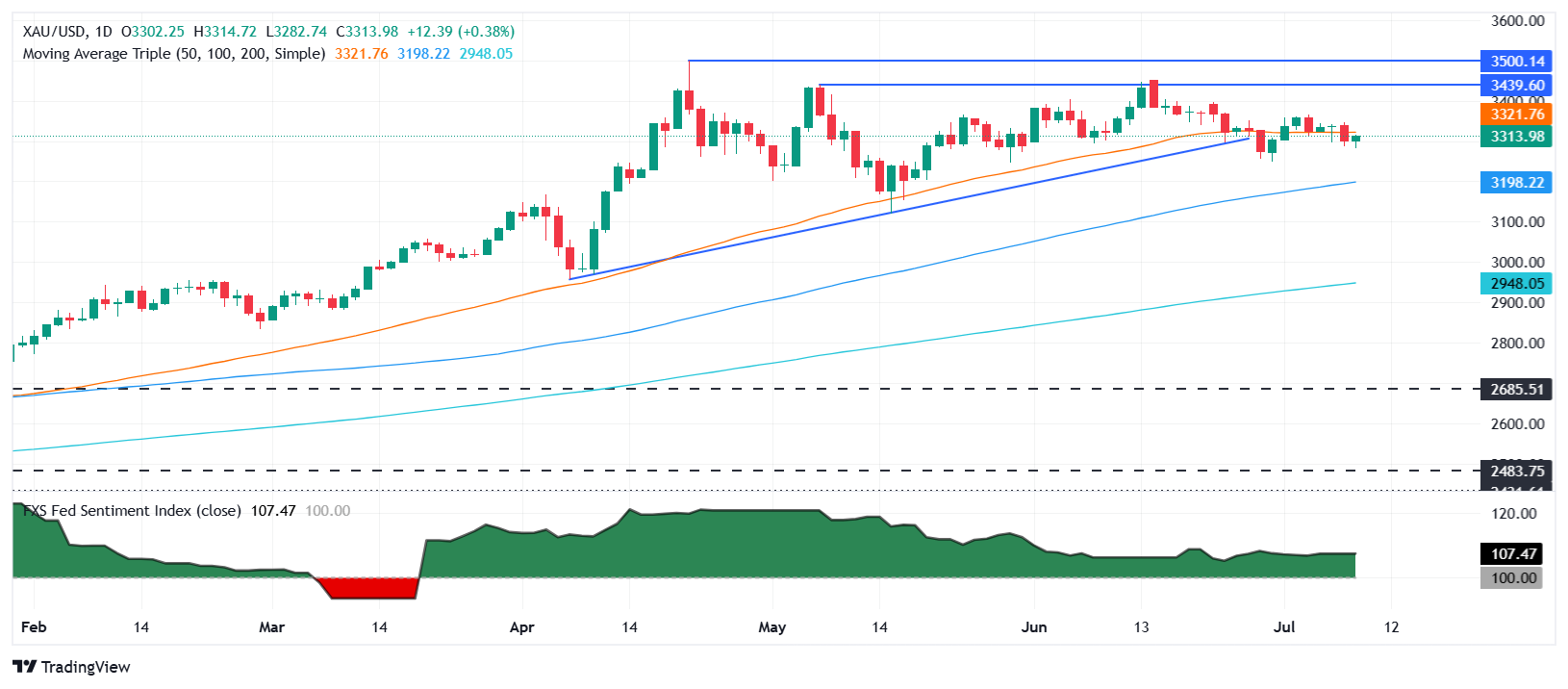Gold rises as Fed minutes signal 2025 cuts, US yields retreat
- Gold is supported by falling US Treasury yields despite a firm US Dollar.
- Fed minutes show broad support for at least one rate cut in 2025.
- Trump targets BRICS-aligned nations with fresh 10% tariff warnings.
Gold price registers decent gains on Wednesday as US Treasury yields recede, even though the Greenback trades solidly against its peers. Trade developments continued to dictate the market’s direction, while the latest minutes indicate that officials are still considering a rate cut in 2025. At the time of writing, the XAU/USD trades at $3,312, up 0.31%.
The Fed’s minutes showed that most officials see a rate cut to the Fed funds rate this year as appropriate, while a couple are considering a reduction in July, if data evolves as expected.
The White House continues to deliver blows to minor and major trading partners, releasing the latest batch of letters to countries like the Philippines, Moldova, Algeria, Iraq, Libya, Brunei, and Sri Lanka. Duties were set at around 20% to 30% for the countries mentioned.
On Wednesday, the US President Donald Trump emphasized that he would apply 10% additional tariffs to countries aligning themselves with anti-American policies of the BRICS.
Data from the Chicago Board of Trade revealed that market players are eyeing 50 basis points (bps) of easing in 2025.
Daily digest market movers: Gold price surges as White House announces another tranche of letters
- Gold’s uptrend remains intact, as it remains above strong support near $3,250. The drop in US Treasury yields boosted the yellow metal. The US 10-year Treasury note yield drops six basis points to 4.342%. US real yields are also edging lower by six bps at 1.992%. The US Dollar Index (DXY), which tracks the Greenback’s performance against a basket of currencies, is flat at 97.51.
- FOMC Minutes showed that some Fed officials do not see a rate cut in 2025, citing that inflation pressures remain high, along with inflation expectations edging up and ongoing economic resilience. All participants viewed the current policy rate as appropriate. Participants agreed that stagflationary risks had diminished, though they remain elevated.
- Washington unveiled tariffs to the Philippines (20%), Moldova (25%), Algeria (30%), Iraq (30%), Libya (30%), Brunei (25%), Sri Lanka (30%), and lastly Brazil (50%).
- Trump once again criticized Federal Reserve Chair Jerome Powell, adding that the central bank needs to cut rates by at least 3%. He sent copper prices higher as he is threatening to impose a 50% duty on the red metal.
- Even though the XAU/USD remains pressured, the World Gold Council (WGC) announced that Gold ETFs drew the largest inflow in five years during the first half of 2025. “Gold ETFs recorded an inflow of $38 billion in the first half of 2025, with their collective holdings rising by 397.1 metric tons of Gold.” The total holdings by the end of June rose to 3,615.9 tons, the largest since August 2022.
- The PBoC revealed that it added 70,000 ounces, meaning that the central bank’s Gold reserves increased by 1.1 million ounces since purchases resumed last November.
XAU/USD technical outlook: Gold price clings above $3,300
Gold price upward bias is intact, though it would be facing stiff resistance in the near-term. Although the Relative Strength Index (RSI) is aiming up, it remains bearish, an indication that clearing the 50-day Simple Moving Average (SMA) resistance level at $3,319 would be hard to accomplish. In that outcome, the next ceiling level would be the 20-day SMA at $3,345, $3,350 ahead of $3,400.
Conversely, if XAU/USD tumbles below $3,300, the first support would be the June 30 low of $3,246 to pave the way for further downside, with the 100-day Simple Moving Average (SMA) at $3,185 eyed, followed by the May 15 low of $3,120.

Gold FAQs
Gold has played a key role in human’s history as it has been widely used as a store of value and medium of exchange. Currently, apart from its shine and usage for jewelry, the precious metal is widely seen as a safe-haven asset, meaning that it is considered a good investment during turbulent times. Gold is also widely seen as a hedge against inflation and against depreciating currencies as it doesn’t rely on any specific issuer or government.
Central banks are the biggest Gold holders. In their aim to support their currencies in turbulent times, central banks tend to diversify their reserves and buy Gold to improve the perceived strength of the economy and the currency. High Gold reserves can be a source of trust for a country’s solvency. Central banks added 1,136 tonnes of Gold worth around $70 billion to their reserves in 2022, according to data from the World Gold Council. This is the highest yearly purchase since records began. Central banks from emerging economies such as China, India and Turkey are quickly increasing their Gold reserves.
Gold has an inverse correlation with the US Dollar and US Treasuries, which are both major reserve and safe-haven assets. When the Dollar depreciates, Gold tends to rise, enabling investors and central banks to diversify their assets in turbulent times. Gold is also inversely correlated with risk assets. A rally in the stock market tends to weaken Gold price, while sell-offs in riskier markets tend to favor the precious metal.
The price can move due to a wide range of factors. Geopolitical instability or fears of a deep recession can quickly make Gold price escalate due to its safe-haven status. As a yield-less asset, Gold tends to rise with lower interest rates, while higher cost of money usually weighs down on the yellow metal. Still, most moves depend on how the US Dollar (USD) behaves as the asset is priced in dollars (XAU/USD). A strong Dollar tends to keep the price of Gold controlled, whereas a weaker Dollar is likely to push Gold prices up.
